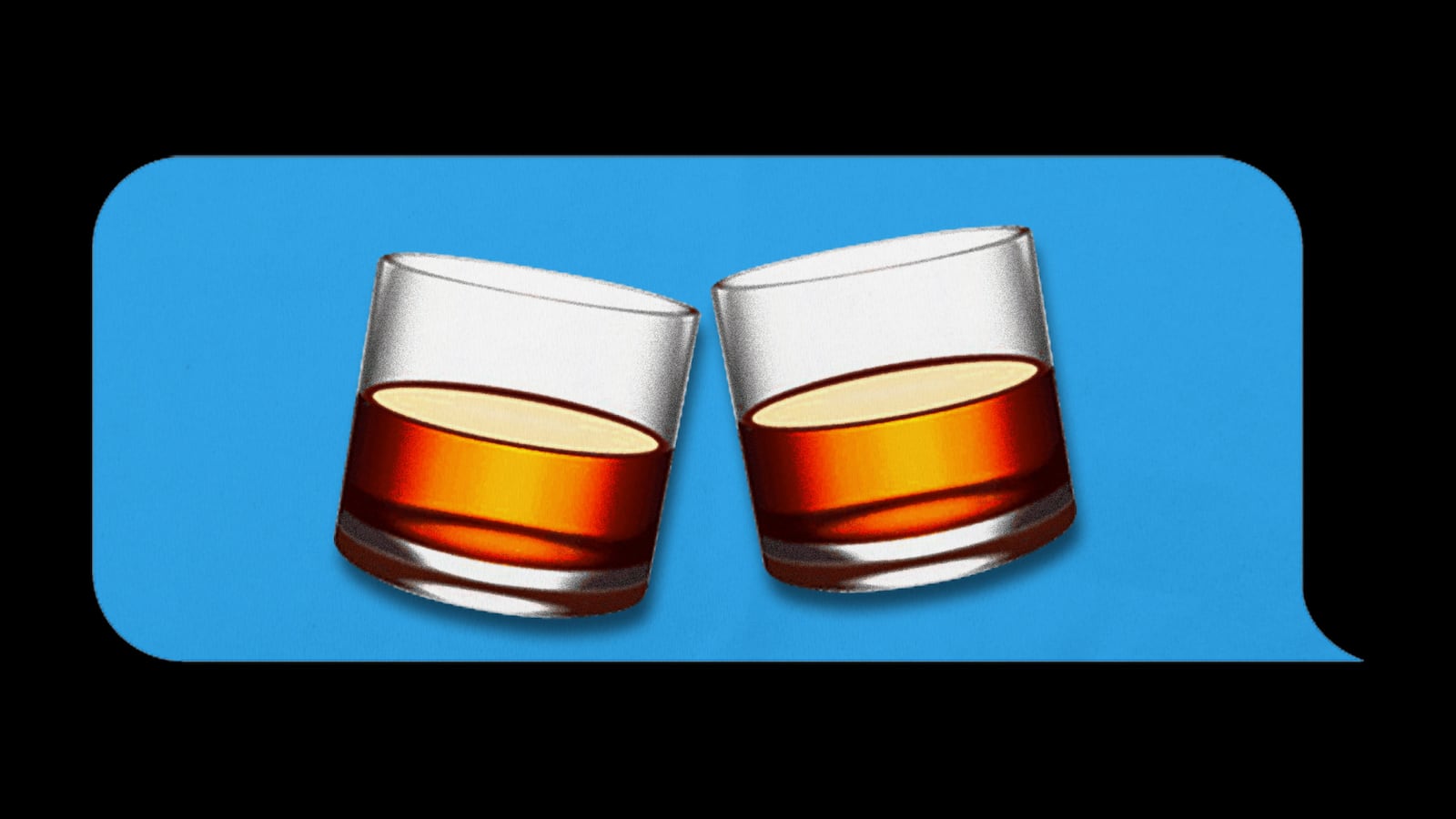Meet Codepoint U+1F943.
That’s the name for what’s commonly called the whiskey glass emoji, at least among those fluent in Unicode speech. It’s basically the Libbey Signature Stinson 12-ounce Rocks Glass half-full with a bourbon that’s been aged six years. At least to my eye—but maybe it’s a Jamaican rum.
Maybe it’s an unsweetened tea.
And that’s only if you’re on an iPhone. If you’re on an Android, the icon is slightly different. It features what I’m pretty sure is the Libbey Preston 13-ounce Rocks Glass, with slightly tapered sides. It is only about one-third filled. And if that’s whiskey, it’s not whiskey you would want to drink. It’s murky and suspiciously multi-hued. Maybe it’s a chocolate Martini that’s gone rogue from U+1F378—Unicode for the cocktail glass emoji.
It’s as if Apple and Android operate different bars and have different specs for the same drinks, just like in real life. I’ll get into this divergence in a moment, but first I have a question for you: How does this whiskey glass emoji make you feel?
That’s what emoticons and emojis were initially designed for: expressing emotion. While proto-emoticons could be found as early as the 1870s (called “typographical art”), the first modern emoticon arose in the early 1980s. This was the sideway smiley face to indicate that what the writer wrote wasn’t actually serious: :-). It was a wink rendered in typographic form.
Conveying emotion in words is complicated. While an attentive writer can convey sarcasm or irony with some deft phrasing, it takes thought and work, especially when texting on those flip phones of yore with Chiclets-like keys. Even then, conveying emotion with words could be open to misinterpretation, especially if your missive was sent to someone whose first language was not your first language.
Emoticons evolved and became ever more complex, with eight-character versions like ¯_(ツ)_/¯ replacing eight-letter words like “whatever” because, you know, convenience. And LOLs.
The beginning of the end of the emoticon occurred in 1999. That’s the year emojis were developed by Shigetaka Kurita, an artist working with a Japanese mobile phone company that catered to teens. He devised the first palette of 176 emojis. Out were punctuation marks conscripted into duty they never signed up for; in were simple 12-by-12-pixel symbols representing things such as a smiling face, the sun, an astrological sign, a baseball, a heart and overly large exclamation points.
Emojis were a more advanced form of digital hieroglyph. The Sideways Smiley and Sideways Winking Smiley expanded their family, adding siblings like Face with Tongue, Winking Face with Tongue, Smiling Face with Heart-Eyes, Smiling Face with Sunglasses and many more.
Emojis were now able to convey more complex emotions than just “happy” and “sad.” Like, “what you wrote makes me want to vomit,” or “oh my god I’m blushing.”
In the United States, techies at Google and Apple caught wind of this trend and sought to ensure that the packets of numbers that represent, well, everything on a computer would be uniformly interpreted regardless of platform. This cluster of numbers would appear on any computer or smartphone as a smiley face; that cluster would come up as a flamenco dancer.
So they petitioned the Unicode Consortium, an international nonprofit that establishes standards of global keyboard compatibility to include emojis in their schemes. In 2010, the Consortium agreed, and the emoji began its ascent to ubiquity. Wiredmagazine wrote that emojis “represent the first language born of the digital world, designed to add emotional nuance to otherwise flat text.”
Now, let me ask again: What sort of emotional nuance does the whiskey glass convey? How does the whiskey glass make you feel?
I personally don’t find the whiskey emoji very celebratory nor uplifting. Then again, I’m a glass- half-empty sort. The glass is austere and seems a little lonely and Willy Loman-ish. I always picture it under a single light in a dim bar that smells of damp towels. Is that Tom Waits over there? Possibly.
Others see it as more festive. Dwayne Johnson is a serial user of the tumbler emoji on Twitter as @TheRock, where he invariably posts it after the word “Cheers.” He used it when celebrating the release of Teremana, his new tequila brand, and was profligate with it when thanking Twitter denizens for liking his summer 2021 movie, Jungle Cruise.
When the first palette of emojis debuted between 2010 and 2015, the drinking scene was limited. It consisted of wine, beer, sake, Martinis and tropical drinks. The whiskey tumbler didn’t join the family until 2016. It actually had an emoticon ancestor. Early on, a crude drink symbol was crafted using Unicode-approved “Ideograph-65E6,” which could be seen as a stylized version of a half-full tumbler on a coaster (旦) This was typically accompanied by symbols depicting a person drinking 旦_( ˚ ‹˚ ) or having drunk ( -_-)旦. It didn’t necessarily mean liquor, though, and was commonly used for tea.
New emojis are proposed by the public and voted upon by Unicode members at regular intervals; after approval, they’re typically folded into the next upgrade of a phone’s operating system. Each phone operating system chooses the art it wants to use to depict the icon, so that’s how you get variations. Consider the tropical drink emoji: Apple’s featured a lime and a cherry garnish; Samsung’s had a cocktail umbrella and was originally swimming-pool blue. An early Android version of the wine glass contained a liquid that was very orange and looked more like cognac than cabernet.
So the whiskey tumbler varied in appearance depending whether you were using Apple or Android. Further variations flared up elsewhere. The Samsung, Twitter and Microsoft tumbler featured a single large ice cube; one had a sphere and the others ice from one of the better Hoshizaki ice machines.
A dust-up arose with the iOS 11.1 upgrade in October 2017, in which Apple subtly altered the whiskey glass. The tumbler suddenly had higher sides and was depicted as viewed straight on rather than from slightly above. But it was the liquid within that was most controversial—it was no longer a lucid and inviting amber, but something murkier. Maybe an apple juice or a flat soda? Rumors arose that Apple was catering to the anti-alcohol crowd and wanted it more ambiguous. Uproar ensued. In the next operating system upgrade two months later, it went back to the original version, where it has since remained.
Since the whiskey tumbler was released, several other beverage emojis have been released. In 2017, the Cup with Straw came out—also known as the Go-Cup, which was handy during a pandemic in which to-go drinks became more widespread. And in 2019, the Mate Drink (a gourd with a metal straw) and Juice Box were rolled out, occupying opposite ends of the commercial drinks spectrum.
Coming later this year, as part of Emoji 14.0, is “Pouring Liquid,” which depicts a glass pouring out a bright blue liquid that can be interpreted as either water or blue Curaçao, depending upon your tribe. The new emoji will likely surface on your phone sometime in mid-2022. What this represents is uncertain, but perhaps reflects the rise of the Sober Curious.
One other drinking vessel has been pushing for recognition—the porrón. It’s a glass wine pitcher popular in Catalonia featuring a long and delicate spout that allows drinkers to pour a thin stream of wine into their mouths without touching their lips to it. Versions of it have been around since at least the 15th century, and yet it seems modern and made for an endless pandemic.
It is not a universally popular vessel. George Orwell in Homage to Catalonia wrote, “I went on strike and demanded a drinking-cup as soon as I saw a porrón in use.” But supporters of the new emoji will have none of this, and point out in their petition that “it helps to create community, to strengthen the bonds during the meals [and is] a way to understand a life of sharing.”
Which, it should be said, is also true of Codepoint U+1F943.





